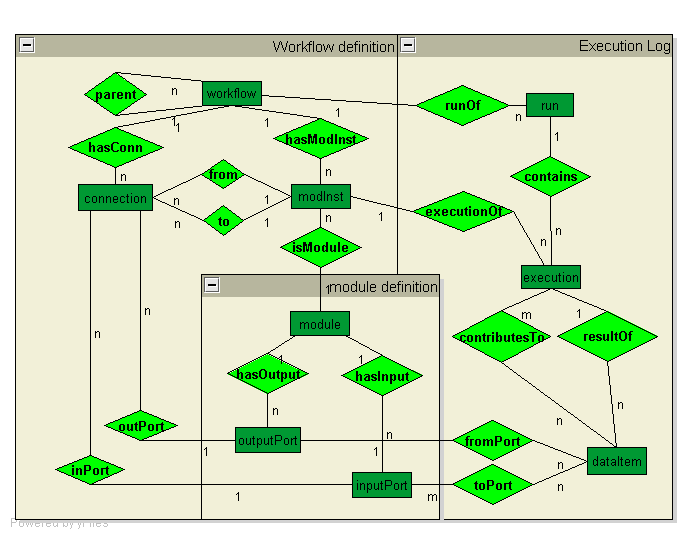Provenance challenge
Second provenance challenge design overview
This page describes the implementation of how to answer the queries of the second provenance challenge.
The goal of this project is to create an api capable of querying different kinds of databases containing provenance data. The main focus will be on provenance generated by scientific workflows.
data model overview
This is a description of the data model that i am trying to implement.
Module definition is a description of a processor that takes inputs and generates outputs.
Workflow definition is a description of a workflow that contains modules and connections between them through ports. In the case of VisTrails, it also contains the evolution of the workflow through a parent relation.
Execution log is the information about a workflow execution. It contains information about the processors that were executed and the data items that were created.
primitives
The api will deal with the basic primitives describing workflow executions.
node types:
| name | description |
|---|---|
| dataitem | a dataitem that is input/output to a module execution |
| module | the module/service that is to be executed |
| moduleInstance | the module as represented in a workflow |
| moduleExecution | the execution of a module |
| workflow | a description of a process containing modules and connections |
| workflowExecution | the representation of a workflow execution |
| inputPort | represents a specific port thas can be assigned an input to a module execution |
| outputPort | represents a specific port thas can contain a product of a module execution |
| connection | represents a connection between module Instances |
In addition, for the information contained in each primitive, we suggest using an annotation relation for extracting the information. It should be possible to add custom annotations to all primitives. Widely used information like execution start and end-time might be implemented as separate functions.
Relations
The basic relations between the primitives is shown in the diagram above. However few of the current provenance systems contains all of this information. Some may lack information about produced data items or miss the definition of a workflow. The goal must thus be to extract as much information as possible from each source.
Upstream
The most common use of provenance data will be to perform the transitive closure of some connected executions or data items i.e. to track data dependencies back and forward in time. We call this upstream for tracking back in time and downstream for tracking forward in time.
We have identified 4 primitives to which upstream/downstream tracking is relevant:
| primitive | description |
|---|---|
| dataitem | tracking data dependencies |
| moduleExecution | tracking execution dependencies |
| moduleInstances | tracking module dependencies within a workflow |
| workflow | tracking workflow design history e.g. different workflow versions in the VisTrails action tree |
For a more general transitive function we propose:
- traverse(start,end,limit)
The definition is: start is the start point and end is the endpoint. Limit is the max number of steps to search where 0 means no limit. If start or end is omitted e.g. '*', the function should continue to traverse until no more results are found or limit is reached.
Examples:
- traverse(start,*,0) (downstream)
- traverse(*,end,0) (upstream)
- traverse(start,end,0) (find all elements in between)
Implementation
The implementation is done in python. Currently the API has been partially implemented for XML using XPath and RDF using SPARQL.
There are currently three ways to implement the transitive closure:
- Natively in the Query processor (not implemented yet)
- As an extra graph structure as described below
- An implementation in python using basic relation queries on the source. (Very slow)
For small data stores any implementation is possible. For large data stores (2) might not be possible. If (1) is not possible in the query engine, your only choice is (3), which might be very slow. An assumption would be that an implementation of a provenance store would probably support (1). Or implement its own version of (2).
For query processors not capable of transitive closure (like the ones above), we have implemented a Graph structure. During initialization it loads the transitive relations in the data store. All upstream/downstram queries will then be directed to that Graph structure for fast computation.
--Tommy 03:40, 13 April 2007 (MDT)--
